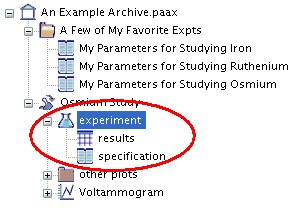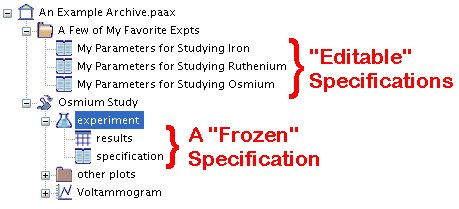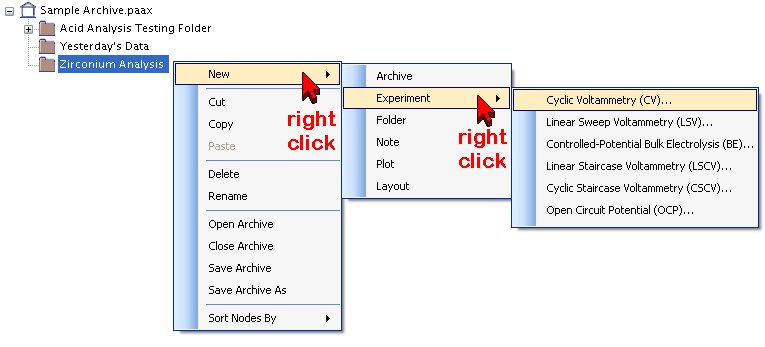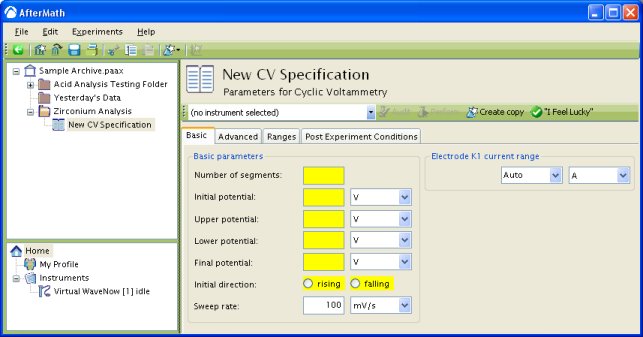
This article is part of the AfterMath Data Organizer User’s Guide
Experimental Parameters
 When an experiment is performed on an instrument, two fundamental types of information become associated with that experiment. The most obvious information generated by the experiment is the raw data or set of measurements made by the instrument. The less obvious, but equally important, information associated with the experiment is how the experiment was performed (i.e., the set of parameters which specify how to do this experiment). These parameters, collectively called an experiment specification, must be configured ahead of time (by you) so that the AfterMath software (and the instrument being controlled by AfterMath) can perform the desired experiment.
When an experiment is performed on an instrument, two fundamental types of information become associated with that experiment. The most obvious information generated by the experiment is the raw data or set of measurements made by the instrument. The less obvious, but equally important, information associated with the experiment is how the experiment was performed (i.e., the set of parameters which specify how to do this experiment). These parameters, collectively called an experiment specification, must be configured ahead of time (by you) so that the AfterMath software (and the instrument being controlled by AfterMath) can perform the desired experiment.
 Once the experiment is completed, it is very important to bind together both the raw data and parameters which describe how the data was generated. This binding of experimental data with an experimental specification is strictly enforced by the AfterMath software.
Once the experiment is completed, it is very important to bind together both the raw data and parameters which describe how the data was generated. This binding of experimental data with an experimental specification is strictly enforced by the AfterMath software.
When you look into an AfterMath archive which contains the results from a previously completed experiment, this strict binding is very apparent. In the example to the left, an experiment (represented graphically as a flask) contains two other items. The first item is a data table (named “results”) containing the measurements made during the experiment. The second item is an experiment specification (named “specification”) which is a record of the parameters used to make the measurements.
Unlike most other items found in an archive, AfterMath will not permit you to delete, move, or otherwise separate the experiment data from the experiment specification. The specification is “frozen” in a read-only state so that you do not accidently change the record of how the experiment was performed. However, AfterMath will permit you to make an “editable” copy of the experiment specification and store it somewhere else in the archive. The purpose of this editable specification is to give you an easy way to repeat the experiment using the same set of parameters, or if you wish, to make some modifications to the parameters in order to perform a slightly different, but related, experiment.
Editable vs. Frozen Specifications
An reasonably sized archive is likely to contain many different experiment specifications. Some of these experiment specifications are likely to be bound to an experiment (“frozen”) while others are not bound to any experiment (“editable”). The latter might be humorously referred to as free range specifications as they are not confined to any one location in the archive and can be moved freely to any folder you wish.
In the example archive shown below, there are three freely “editable” specifications (located in the folder called “A Few of My Favorite Expts”), and there is one specification that is “frozen” because it is bound to the record of a previously completed experiment.
Editable specifications are usually the first kind of specification that you will create in an archive. When you are ready to configure a new experiment, you will first create a new “editable” specification which describes the experiment at some location in your archive. Then, you will issue a command to the instrument to perform the experiment. When the experiment is completed, AfterMath will automatically store the experiment results in the same location in the archive. AfterMath automatically makes a “frozen” copy of the specification and binds it to the experiment results.
Editable specifications are quite useful in those situations where you perform experiments with the same parameters over and over again. You can use an editable specification to store these parameters, and then reuse the same specification repeatedly to perform a series of identical experiments.
Creating an Editable Specification
An editable experiment specification can be created in an archive by right-clicking on the folder in which you would like to place the specification. Choose the “New»Experiment” option from the popup menu (see below), and then select the kind of experiment you wish to configure. In the example below, a new specification for a cyclic voltammetry experiment is created.
Once the new specification has been created, you may edit the parameters in the main viewing area. Parameters which are shaded in yellow are mandatory. If you provide an invalid value for a parameter, it will be shaded in pink. If you would like a set of default parameters to be provided by the software, click on the “I Feel Lucky” button.
The “Basic” tab on an experiment specification contains those parameters which are most often needed. The other tabs generally hold more advanced options which are not as frequently changed.







Comments: